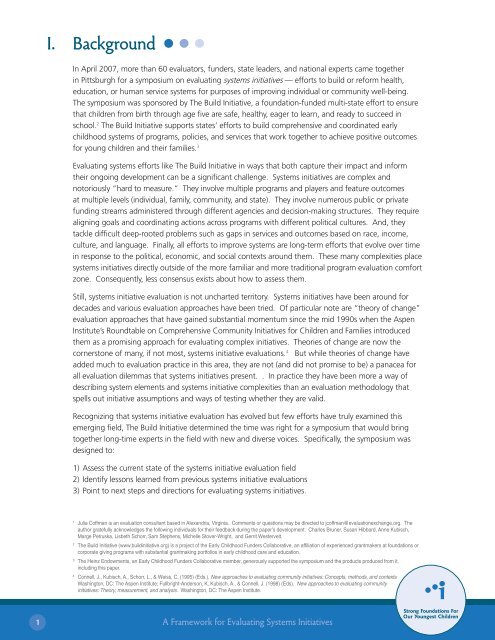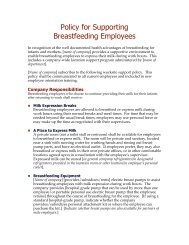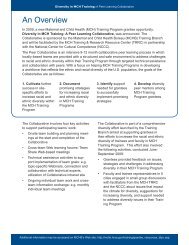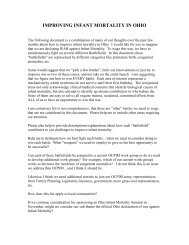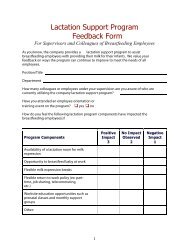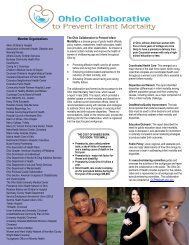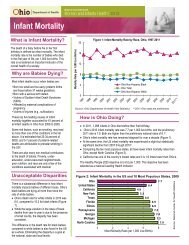A Framework for Evaluating Systems Initiatives
A Framework for Evaluating Systems Initiatives
A Framework for Evaluating Systems Initiatives
- No tags were found...
You also want an ePaper? Increase the reach of your titles
YUMPU automatically turns print PDFs into web optimized ePapers that Google loves.
I. BackgroundIn April 2007, more than 60 evaluators, funders, state leaders, and national experts came togetherin Pittsburgh <strong>for</strong> a symposium on evaluating systems initiatives — ef<strong>for</strong>ts to build or re<strong>for</strong>m health,education, or human service systems <strong>for</strong> purposes of improving individual or community well-being.The symposium was sponsored by The Build Initiative, a foundation-funded multi-state ef<strong>for</strong>t to ensurethat children from birth through age five are safe, healthy, eager to learn, and ready to succeed inschool. 2 The Build Initiative supports states’ ef<strong>for</strong>ts to build comprehensive and coordinated earlychildhood systems of programs, policies, and services that work together to achieve positive outcomes<strong>for</strong> young children and their families. 3<strong>Evaluating</strong> systems ef<strong>for</strong>ts like The Build Initiative in ways that both capture their impact and in<strong>for</strong>mtheir ongoing development can be a significant challenge. <strong>Systems</strong> initiatives are complex andnotoriously “hard to measure.” They involve multiple programs and players and feature outcomesat multiple levels (individual, family, community, and state). They involve numerous public or privatefunding streams administered through different agencies and decision-making structures. They requirealigning goals and coordinating actions across programs with different political cultures. And, theytackle difficult deep-rooted problems such as gaps in services and outcomes based on race, income,culture, and language. Finally, all ef<strong>for</strong>ts to improve systems are long-term ef<strong>for</strong>ts that evolve over timein response to the political, economic, and social contexts around them. These many complexities placesystems initiatives directly outside of the more familiar and more traditional program evaluation com<strong>for</strong>tzone. Consequently, less consensus exists about how to assess them.Still, systems initiative evaluation is not uncharted territory. <strong>Systems</strong> initiatives have been around <strong>for</strong>decades and various evaluation approaches have been tried. Of particular note are “theory of change”evaluation approaches that have gained substantial momentum since the mid 1990s when the AspenInstitute’s Roundtable on Comprehensive Community <strong>Initiatives</strong> <strong>for</strong> Children and Families introducedthem as a promising approach <strong>for</strong> evaluating complex initiatives. Theories of change are now thecornerstone of many, if not most, systems initiative evaluations. 4 But while theories of change haveadded much to evaluation practice in this area, they are not (and did not promise to be) a panacea <strong>for</strong>all evaluation dilemmas that systems initiatives present. . In practice they have been more a way ofdescribing system elements and systems initiative complexities than an evaluation methodology thatspells out initiative assumptions and ways of testing whether they are valid.Recognizing that systems initiative evaluation has evolved but few ef<strong>for</strong>ts have truly examined thisemerging field, The Build Initiative determined the time was right <strong>for</strong> a symposium that would bringtogether long-time experts in the field with new and diverse voices. Specifically, the symposium wasdesigned to:1) Assess the current state of the systems initiative evaluation field2) Identify lessons learned from previous systems initiative evaluations3) Point to next steps and directions <strong>for</strong> evaluating systems initiatives.1Julia Coffman is an evaluation consultant based in Alexandria, Virginia. Comments or questions may be directed to jcoffman@evaluationexchange.org. Theauthor gratefully acknowledges the following individuals <strong>for</strong> their feedback during the paper’s development: Charles Bruner, Susan Hibbard, Anne Kubisch,Marge Petruska, Lisbeth Schorr, Sam Stephens, Michelle Stover-Wright, and Gerrit Westervelt.2The Build Initiative (www.buildinitiative.org) is a project of the Early Childhood Funders Collaborative, an affiliation of experienced grantmakers at foundations orcorporate giving programs with substantial grantmaking portfolios in early childhood care and education.3The Heinz Endowments, an Early Childhood Funders Collaborative member, generously supported the symposium and the products produced from it,including this paper.4Connell, J., Kubisch, A., Schorr, L., & Weiss, C. (1995) (Eds.). New approaches to evaluating community initiatives: Concepts, methods, and contextsWashington, DC: The Aspen Institute; Fullbright-Anderson, K, Kubisch, A., & Connell, J. (1998) (Eds). New approaches to evaluating communityinitiatives: Theory, measurement, and analysis. Washington, DC: The Aspen Institute.1A <strong>Framework</strong> <strong>for</strong> <strong>Evaluating</strong> <strong>Systems</strong> <strong>Initiatives</strong>


